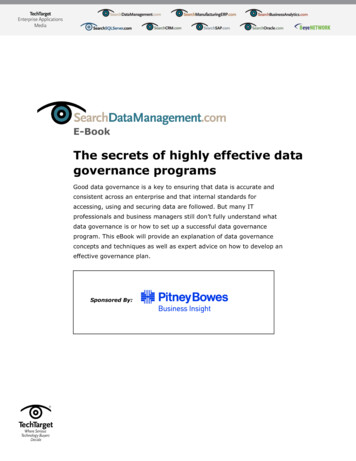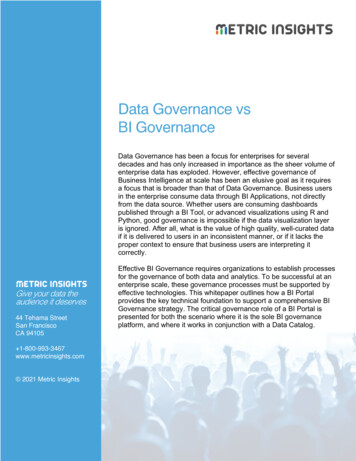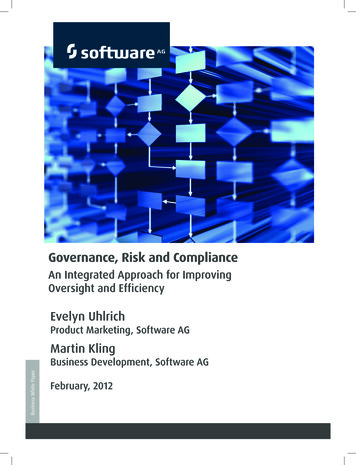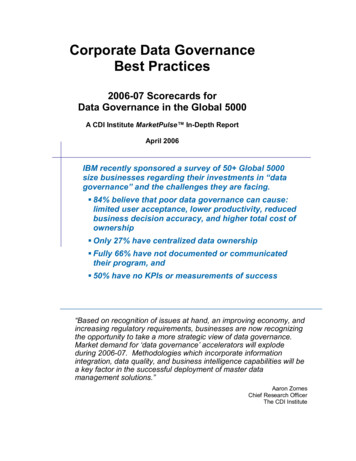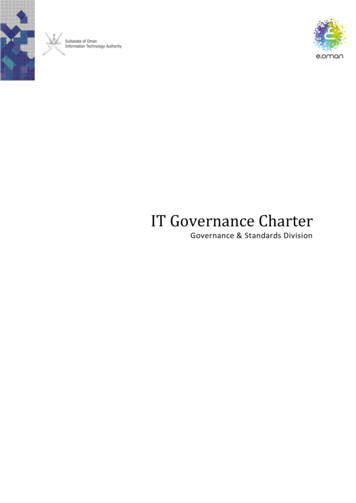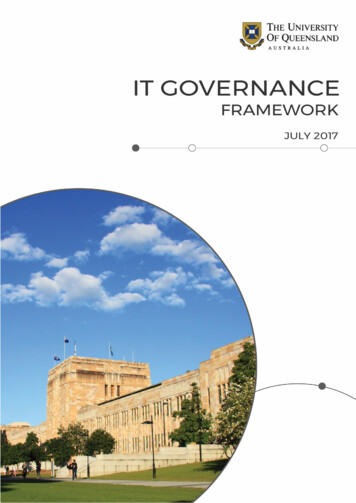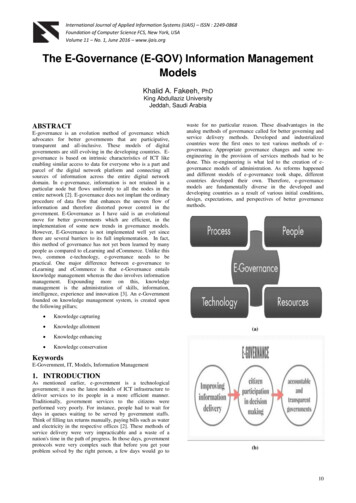
Transcription
International Journal of Applied Information Systems (IJAIS) – ISSN : 2249-0868Foundation of Computer Science FCS, New York, USAVolume 11 – No. 1, June 2016 – www.ijais.orgThe E-Governance (E-GOV) Information ManagementModelsKhalid A. Fakeeh, PhDKing Abdullaziz UniversityJeddah, Saudi ArabiaABSTRACTE-governance is an evolution method of governance whichadvocates for better governments that are participative,transparent and all-inclusive. These models of digitalgovernments are still evolving in the developing countries. Egovernance is based on intrinsic characteristics of ICT likeenabling similar access to data for everyone who is a part andparcel of the digital network platform and connecting allsources of information across the entire digital networkdomain. In e-governance, information is not retained in aparticular node but flows uniformly to all the nodes in theentire network [2]. E-governance does not implant the ordinaryprocedure of data flow that enhances the uneven flow ofinformation and therefore distorted power control in thegovernment. E-Governance as I have said is an evolutionalmove for better governments which are efficient, in theimplementation of some new trends in governance models.However, E-Governance is not implemented well yet sincethere are several barriers to its full implementation. In fact,this method of governance has not yet been learned by manypeople as compared to eLearning and eCommerce. Unlike thistwo, common e-technology, e-governance needs to bepractical. One major difference between e-governance toeLearning and eCommerce is that e-Governance entailsknowledge management whereas the duo involves informationmanagement. Expounding more on this, knowledgemanagement is the administration of skills, information,intelligence, experience and innovation [3]. An e-Governmentfounded on knowledge management system, is created uponthe following pillars; Knowledge capturing Knowledge allotment Knowledge enhancing Knowledge conservationwaste for no particular reason. These disadvantages in theanalog methods of governance called for better governing andservice delivery methods. Developed and industrializedcountries were the first ones to test various methods of egovernance. Appropriate governance changes and some reengineering in the provision of services methods had to bedone. This re-engineering is what led to the creation of egovernance models of administration. As reforms happenedand different models of e-governance took shape, differentcountries developed their own. Therefore, e-governancemodels are fundamentally diverse in the developed anddeveloping countries as a result of various initial conditions,design, expectations, and perspectives of better governancemethods.(a)KeywordsE-Government, IT, Models, Information Management1. INTRODUCTIONAs mentioned earlier, e-government is a technologicalgovernment; it uses the latest models of ICT infrastructure todeliver services to its people in a more efficient manner.Traditionally, government services to the citizens wereperformed very poorly. For instance, people had to wait fordays in queues waiting to be served by government staffs.Think of filling tax returns manually, paying bills such as waterand electricity in the respective offices [2]. These methods ofservice delivery were very impracticable and a waste of anation's time in the path of progress. In those days, governmentprotocols were very complex such that before you get yourproblem solved by the right person, a few days would go to(b)10
International Journal of Applied Information Systems (IJAIS) – ISSN : 2249-0868Foundation of Computer Science FCS, New York, USAVolume 11 – No. 1, June 2016 – www.ijais.org2. MODELS OF E-GOVERNANCE INDEVELOPING COUNTRIES:1.Critical flow model2.Comparative analysis model3.Wider/Broadcasting dissemination model4.Interactive service model5.Mobilization and lobbying modelThese models show some variations depending on the generallocal situation and the functions of governance throughoutthese models [5]. Various features of all e-governance modelsinclude the following; Standard health services and information Legislation and executions of laws Access to government officials and their offices Address on shared environmental challenges throughthe digital platform Warnings to the citizens in case of any predictabledisaster such as earthquakes and floods2.1 Critical Flow ModelA critical flow model of e-governance is a digital governancethat’s operates within private and public domains. This modelhas been able to address and access information such as:(c) Violations of human rights Security threats Information on corruption both in the public andprivate sectors The green ratings of a companyFigure 2: Critical Flow Model2.1.1(d)Figure 1 (a,b,c,d): E-Governance Four Pillars &ArchitecturePrincipal of OperationThe critical flow model is based on distributing key value datato the targeted people or by disseminating it to the broad publicusing any available convergent media or through ICT. Thismodel requires the users to understand the importance of anydata set and how to use it strategically. Also, it may involveestablishing the position of users to whom the accessibility ofparticular data can make a significant difference inimplementing good governance. The vigor of this model is theinbuilt uniqueness of ICT which makes the concept of timeredundant and distance. This concept lowers cases ofexploiting governments which are possible as due to the timelag between availability of data between various users.11
International Journal of Applied Information Systems (IJAIS) – ISSN : 2249-0868Foundation of Computer Science FCS, New York, USAVolume 11 – No. 1, June 2016 – www.ijais.orgApplications of critical flow egovernance2.1.2a.Availing appraisal commissioned by the governmentto the people, research studies, and reports of inquiryb.Availing records of human rights violation andcriminal impeachment against government officialsto concerned citizens and non-governmentalorganizations [7]c.Facilitating information on the corruption ofparticular government officials or ministries to theelectoral bodies or to any relevant governing councild.making available information on the environment tothe local citizens such as effluent discharge to rivers,sources of radioactive elements which are a healthhazard just to mention a few2.1.3Evaluation of critical flow modelPros1.Critical model is based mostly on the direction of itsinformation and its prospective users [6]. Byconcentrating on the important aspect of data, it theweakest feature of governance and its decisionmaking body.2.This model informs people about particular instancesof political failure and improper governance.3.While fuelling public strife, this system puts pressureon the responsible government officials and bodies totake into consideration the concerns and the opinionsof citizens while making decisions.actively endorse human rights changes in the politicalboundaries of Bangladesh. Also, the portal supports women,marginalized communities, children and citizen in resisting anysocial repression.Transparency International's Corruption NewsThis organization runs a website called “The Daily corruptionNews” that reports on all corruption cases globally.2.2 Comparative Analysis ModelOperation principle- though this is the least growing model ofgovernance, it is highly effective hence the reason why it isgaining popularity gradually. This model operates with aparticular purpose of exploring information from both theprivate and public domain and compare it with the knowninformation hence deriving premeditated learning’s andopinions. Comparative analysis model systematicallyassimilates fresh knowledge products and use them tomanipulate, assess and campaign for change in governanceactions and policies. Benchmarking must be done to comparedifferent events of the past and the current situation, orcompare two separate situations to comprehend the efficiencyof an intercession [8]. The vigor of this model is in ICT whichcan store data in a retrievable manner and share it instantlyacross all networks and beyond any hierarchical orgeographical barriers.Cons1.The government itself may have a limitedmotivation, and attitudes in sharing such importantinformation.2.The only way to achieve such a model is to lay itsimplementation responsibility to civil societies so asto have efficient watch on government actions andpolicies [7]3.4.Figure 3: Comparative Analysis ModelApplications of Comparative AnalysisModel2.2.1The model may not work properly on instanceswhere the government bodies do not encouragepublic contributions and criticize all information ofcritical natureFinally, the model will also fail where thegovernment maintains tight control over allinformation and remains available to only a few toplevels of the government.Successful projects based on criticalflow modelIndiaa.This model establishes the conditions of priorpreference, particularly in the case of legal or judicialdecision-making, and uses it to manipulate howdecisions are made in the future.b.Used in assessing the performance of a particularpublic servant, ministry or the government.c.Enables making informed decisions at allgovernment levels by empowering the background toknow how and provide a justification for the futurecourse of actiond.This model is used to gauge the efficiency of thecurrent policies by digging up lessons from the egovernment guiding principles and measures in thepast.2.1.4India Central Vigilance Committee has a website whichprovides access to information freely about the governmentservants who have been implicated in legal charges related tocorruption to the citizens. In this site, people can filecomplaints aligned with a public servant who falls in thejurisdiction of the commission.BangladeshBangladesh Human Rights Portal: the networking of this portal2.2.2Evaluation (Pros and Cons)ProsThe developing countries can use this model to their benefit asICT unlocks access to local knowledge and global products at12
International Journal of Applied Information Systems (IJAIS) – ISSN : 2249-0868Foundation of Computer Science FCS, New York, USAVolume 11 – No. 1, June 2016 – www.ijais.orgvery low cost.Organizations trusted in maintaining this digital platform mayuse it to track the performance of electoral candidates and sharethe records in their constituencies.ConsThis model can become useless/ ineffective in the absence ofvigorous civil societies welfares and little public memoryAlso, the model relies on the availability of other information’sfor comparison and the attitude of people to examine and comeup with self-explanatory or strong arguments from the analysis.Successful projects based on criticalflow modelPhilippines2.2.3Figure 4: Broadcasting ModelApplications of Wider DisseminationModel2.3.1The Philippines have a website call vote.Ph, which is nonsectored, non-partisan online information bank. This is thereference center for Philippine elected officials on the local andthe national level. This directory is used by voters to know whoruns in their electoral areas and who their currentrepresentative is. Putting into the public domain, the names, contactsand address of government officials Posting government legislations and laws into onlineplatforms for easier access Making significant judicial statements/ judgmentsthat are vital to citizens online Availing information about plans of the governmentsuch as budgets, security conditions, andexpenditures onlineIndiaIndia, the Center for Science and Environment carries outsurveys of how environmental friendly Indian industries are.This project is mainly an attempt to facilitate fair andindependent examination of the relative environmentalperformance of various industries. It attempts to a perspectivewhich supports accountability in industries and on the otherhand encourage poor performers to compete. After evaluation,the performance of these companies is shared online and massopinions implored in deciding the greenest industry.Global projectHuman development indicators- the UNDP report on humandevelopment index makes use of stored statistical dataregarding health, literacy, national income just to mention afew as a benchmark to evaluate the performance of made indifferent countries regarding their organization.2.3 Broadcasting/Wider DisseminationModelPrinciple- this model of e-governance is based on thedistribution of information which is essential for bettergovernance. The work of the model is to reach a wider publicdomain through the use of ICT since this information is alreadyin the public sphere. An informed citizen understandsgovernance mechanism quickly and is in a position to makesober choices in exercising his responsibilities and rights. It islikely that the areas where these informed citizens are willensure that the correct governance methods are implementedwithout fear or favor [8]. Broadcasting model of governanceunlocks up an alternative channel for people to gain access todata and also distribute it to the local or public domain fromoutside sources. When this model is widely spread, iteventually corrects the situation of communication failure andgives people information related to the government so that theycan come up to consensus and decide the future course ofaction.2.3.2EvaluationProsIf national governments aggressively adopt this model, theywill effectively create an environment that enhancesparticipation of its people in domestic matters. This model isthe very first move in achieving e-governance platforms sinceit facilitates free flow and access to information to all parts ofthe society hence can be referred as the building block ofdigital governance [7].ConsThis model is not useful when the government controls theinformation being put in the public domain. Also, the model ispointless when free flow of important content is notencouraged. Therefore, it is the sole responsibility of civilsocieties and government organizations to ensure that thismodel becomes successful.Successful projects based on the widermodel of e-governance:Brazil2.3.3The official National E-government website providescomprehensive information about the government as well asintegrates citizens to the E-governmentSouth AfricaIn South Africa, there is a network called the Chapter 2Network which is a center to clear communication andinformation for social justice. This network distributesinformation about research and political intelligence, supportcampaigns and legislation scrutiny to civil societyorganizations involved in social justice.Earth Negotiations Bulletin- is a network service that keepscitizens around the globe aware of international environmentalnegotiations, decisions, and processes. It’s of primary value to13
International Journal of Applied Information Systems (IJAIS) – ISSN : 2249-0868Foundation of Computer Science FCS, New York, USAVolume 11 – No. 1, June 2016 – www.ijais.orggovernments and the people especially in the developingcountries so as to record international decisions and take thenecessary precautions.2.4 Interactive-Service Model / G2C2Gother models hence making it hard to copy in the developingcountries which lack reliable ICT infrastructureSuccessful projects on InteractiveService Model2.4.3Interactive-service system of government can also be referredto as Government to Citizen to Government model. This modelis a consolidation of different E-governance models and allowsdirect participation of persons in the digital governanceprocess. ICT is used in this model to incorporate all peoplewithin a knowledge network thus enabling interactivecommunication media within them.This model of E-governance has been used in Dhar, which is adistrict in Pradesh. It connects rural cybercafés to cater for theeveryday need of citizens. The site offers services such asonline applications and registrations, copies of land maps, andpublic complaint redress.G2C2G entirely includes the potential of ICT and use it forgreater transparency and efficiency, and participation ingovernment functions as well as saving time and cost related tothe decision-making process. Citizens can access all services ofthe government through this model since it creates a channel infunctions such as government procurements, sharing ofconcerns, filling of tax returns just to mention a few.Secondly the model has been used in Philippines custombureau which is an online system that has been developed toaide in clearance at the ports, duty payment, and delivery oforders for ships to leave the doc. This digital platform hasreduced cases of the graft within government arms hencemaking the revenue bureau maximize revenue collection.Philippine2.5 Mobilization and Lobbying ModelIt is the most common model of E-governance and has alwayshelped civil society organizations to influence global decisionmaking procedures especially in developing countries.Mobilization model is based on strategic, the directed flow ofinformation to strengthen action and build strong allies [9]. Ittakes up a proactive approach of building virtual communitieswhich promote vigorous sharing of information and sharing ofsimilar values. The diversity of these virtual communities is thestrength of this model and the resources, and ideas broughttogether through virtual methods of network.The lobbying model can effectively overcome institutional,geographical and bureaucratic barriers to shape rigorous action.Figure 5: Interactive Service Model2.4.1Applications of G2C2Ga.Used in conducting electronic ballots during electionof government officialsb.Filling of reports and grievances to variousgovernment bodies by the citizensc.Establishing an all-inclusive communication channelsuch as online dialog and video conferencingd.Used in carrying out opinion polls or public debateson issues affecting the everyday citizense.Doing governance functions in an online platformsuch as filing of taxes, revenue collection, andpayment transfers2.4.2Evaluation of G2C2GProsThis model of governance is more applicable in the developednations and has been projected for use in the developingcountries.ConsFigure 6: Mobilization& Lobbying ModelApplications Mobilization andLobbying Model2.5.1a.Formation of groups that compel decision-makingorganizations to recognize their concernsb.Advocating for the rights of the marginalized groupsfrom the decision-making organsc.Compelling for public debates on global issues andthemes of any imminent conferencesd.Advocating for wider involvement in decisionmaking processesThe model is highly reliable to technology as compared to14
International Journal of Applied Information Systems (IJAIS) – ISSN : 2249-0868Foundation of Computer Science FCS, New York, USAVolume 11 – No. 1, June 2016 – www.ijais.org2.5.2Evaluation (Pros and Cons)Pros1.This model gained ground after the onset of theSeattle round of WTO which led to the formationvarious virtual communities that advocate theconcerns of the developing nations in the WTOagreement. This was as a result of massivediscussions that must have taken place over virtualnetworks before the summit.2.The model increases the range of membership ofindividuals and communities in debates and anypolicy issues.3.The model creates a limit for members to be carefulor get the opinion of the global members is againstthem [9].4.This model can also be used to gauge public opinionsby the government, especially on particular issues.Non-internet e-governmentAn e-government is always thought to be an onlinegovernment; however there are lots of non internet electronicgadgets which can be used in this context. Some of these noninternet devices include fax, telephone, and message textingand wireless network services. These modes of transmittingdata without the need of being connected to the internet make anon-internet e-government.Merits of an e-governmentEfficiency in service delivery: delivery of services to citizenshas become much more efficient as information for theordinary man is stored or can be accessed online hence no needfor him to carry too much forms such as certificates [12]Improved services: compared to the traditional methods ofgiving services, e-governance has improved service delivery asthere are no longer too much wastage of time in processing thedata of a citizenEnhanced accessibility of public services: one can accesshis/her own information at his own convenient time. You nolonger need to queue for so long for the simple reason ofpaying your water bills. This service can be accessed andsorted within the e-governance online platform.Transparent and accountable government agents: there are nomore loop loopholes which government officials alwaysutilized to perform illegal transactions such as corruptionadvantages related to the idea of E-governance. Through thisreport, you can be sure that E-governance models bringadequate transformations in the on hand forms of governanceas they transform the situation of citizen governancerelationship and bring in a new era of influencing governancedecision-making processes. E-governance models make certainthat the voice of the people is reflected in the decision-makingorgans [12]. Democratic control is fostered over social,economic and welfare policies by civil societies and citizens.This is important for shaping responsive and good governance.The relationship between the citizens and government has beenimproved tremendously through the models of digitalgovernance. Information flows freely both vertically, laterallyhence covering a wider basis of civil society. Freedom ofexpression, therefore, gets exercised well by the citizens whoare willing to be a part of the political processes. In Egovernance models, it is hard to capitalize information for anypolitical gains at the expense of unaware citizens. Digitalgovernance facilitates equal sharing of power among citizens,civil societies, and the opposition parties. Since methods suchas direct participation, opinion casting, and participating inpublic debates, there is greater chance to influence civilsocieties and policy makers. Since the voice of the people iswell heard through digital governance platforms, policy makerscan involve them efficiently in policy making decisions.Government officials realize that their actions are wellscrutinized by the people and civil societies hence they have tobe very careful. Through E-governance, it is very hard tomanipulate information hence the memory of institutions andthe people is always intact.4. REFERENCES[1] "Government to Employee". Eon Technologies. Retrieved2010-01-18.[2] Dawes, Sharon S. "The Evolution and ContinuingChallenges of E-Governance." - Dawes. Wiley OnlineLibrary, n.d.[3] Bertot, Jaegar, and McClure, (2008). "Citizen Centered EGovernment Services: Benefits, Costs, and ResearchNeeds". Montreal, Canada.[4] "U.S. Department of Labor E-Government StrategicPlan". United States Department of Labor. Retrieved2010-01-19.[5] Garson, D.G. (2006). Public Information Technology andE-Governance. Sudbury, MA: Jones and BartlettPublishers. The cost of managing various e-governance modelsis expensive.[6] Saugata, B., and Masud, R.R. (2007). Implementing EGovernance Using OECD Model(Modified) and GartnerModel (Modified) Upon Agriculture of Bangladesh. IEEE.1-4244-1551-9/07. To manage an e-government IT center is verycomplex.[7] White, Jay D. (2007) Managing Information in the PublicSector. M.E. Sharpe. New York One of the most challenging things in a technologicalinformation platform is to maintain security of thedata [12]. Once data is lost where there is no backup, then retrieving it will be expensive.Demerits of e-governance[8] Fang, Zhiyuan. "E-government in Digital Era: Concept,Development, and Practice." International Journal of theComputer 10.2 (2002): 1-223. CONCLUSION[9] Carter, Lemuria, and France Belanger. "Citizen Adoptionof Electronic Government Initiatives. IEEE Xplore.Virginia Polytechnic Institute and State University, n.d.Every government, either in the developed or the developingcountries should work towards achieving a digital governancemodel. As illustrated in this report, there are numerous[10] "On demand government". The Daily Telegraph(London). 18 November 2003. Retrieved 2010-01-19.15
International Journal of Applied Information Systems (IJAIS) – ISSN : 2249-0868Foundation of Computer Science FCS, New York, USAVolume 11 – No. 1, June 2016 – www.ijais.org[11] "E-Government for Developing Countries:Opportunitiesand Challenges". The Electronic Journal on InformationSystems in Developing Countries (EJISDC). 2004.[12] Moon, M. J. (2002), The Evolution of E-Governmentamong Municipalities: Rhetoric or Reality?. PublicAdministration Review, 62: 424–433[13] Marche, S. and McNiven, J. D. (2003), E-Government andE-Governance: The Future Isn't What It Used To Be.CAN J ADM SCI, 20: 74–86.[14] Mary Maureen Brown. "Electronic Government" JackRabin (ed.). Encyclopedia of Public Administration andPublic Policy, Marcel Dekker, 2003, pp. 427–432.[15] Bakry, S. H. “Development of e-government: a STOPEview.” International Journal of Network Management.2004, 14(5), 339-350.16
model requires the users to understand the importance of any (d) Figure 1 (a,b,c,d): E-Governance Four Pillars & Architecture implementing good governance. The vigor of this model is the . MODELS OF E-GOVERNANCE IN DEVELOPING COUNTRIES: 1. Critical flow model 2. Comparative analysis model 3. Wider/Broadcasting dissemination model 4.




